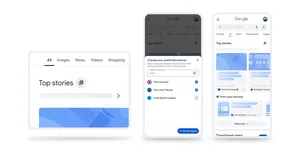Humans behind Search: Meet Guy
Guy is lead product manager at the Journalist Studio, where he works on tools to support the work of journalists.
Tell us about your work in Search and how it helps journalists worldwide.
My team works on Google Trends and Pinpoint, amongst other products that are still in incubation. All sit within the Journalist Studio, which is a collection of tools that help journalists to do their work more efficiently, creatively, and securely.
How is Google Trends helpful for journalists?
Being able to see what people are searching for gives an accurate insight into the topics of the day – or indeed month or year, spanning anything from sporting events and seasonal recipes to news stories and celebrity gossip. It’s therefore super useful to journalists, who use Google Trends a lot – to help them uncover new story ideas, or to complement their research and enhance their storytelling. Every year we share a Year In Search round up, and it’s hugely exciting for our team to see media around the world talking about the changing themes that are shown.
What problem does Pinpoint solve for journalists?
Reporters often have to spend a lot of time sifting through large collections of handwritten documents, images and audio recordings. This material can range from freedom of information requests, which can return hundreds of thousands of documents, to court hearing transcripts or police reports. Similarly, audio material can be lengthy interviews or weekly council meeting recordings and so on. Sometimes reporters know what they’re looking for and sometimes they have to skim thousands of pages or listen to hours of audio just to figure it out – and often with intense deadlines looming.
Using advanced AI, Pinpoint processes documents and images, and indexes them so users can search for keywords, or easily find names of people, places or organizations. Similarly, it transcribes audio recordings, turning them into searchable text. So for reporters, it’s taking a task that would have taken a few people weeks to achieve, and shrinking it into a task that they can do alone, and more accurately, in just a few hours. We’ve had incredible feedback from journalists across the globe about how Pinpoint is an amazing time saver.
Academic researchers and students also find Pinpoint useful and so we also allow them access too.
What’s been the most exciting part of working on Pinpoint?
The initial research was fascinating because it was quite a new world for our team. We spent a lot of time attending journalistic conferences, running user studies to hear about what they needed, paying attention not just to what they were saying but also to what they weren’t saying, to see if there were deeper needs that we could solve.
I was most excited about the immersion trips where the team spent two or three days in newsrooms around the world from early morning to evening. We saw everything from how they run their editorial meetings to how they make their coffee, their running jokes, and so on – really immersing ourselves into their professional life.
So it was about learning and distilling the huge breadth of their needs on the one hand, and exploring a broad set of Google’s technological capabilities on the other. Then bringing them together. It was really exciting to find the sweet spot of where those two intersected.






